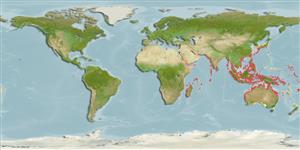Common names from other countries
Environment: milieu / climate zone / depth range / distribution range
Sinh thái học
. Tropical
Indo-West Pacific.
Length at first maturity / Bộ gần gũi / Khối lượng (Trọng lượng) / Age
Maturity: Lm ? range ? - ? cm Max length : 4.0 cm SHL con đực/không giới tính; (Ref. 348); common length : 2.5 cm SHL con đực/không giới tính; (Ref. 348)
Local artisanal exploitation (Ref. 348). In sand and beach slopes in surf zones, migrating between the high and low tide marks with ebb and flow tides. Sometimes abundant. Occurs from low and high tide mark. Found burrowing in exposed sandy beaches (Ref. 125338).
Life cycle and mating behavior
Chín muồi sinh dục | Sự tái sinh sản | Đẻ trứng | Các trứng | Sự sinh sản | Ấu trùng
Members of the class Bivalvia are mostly gonochoric, some are protandric hermaphrodites. Life cycle: Embryos develop into free-swimming trocophore larvae, succeeded by the bivalve veliger, resembling a miniature clam.
Poutiers, J.M. 1998. (Ref. 348)
IUCN Red List Status (Ref. 130435)
CITES status (Ref. 108899)
Not Evaluated
Not Evaluated
Threat to humans
Harmless
Human uses
| FishSource |
Các công cụ
Các nguồn internet
Estimates based on models
Preferred temperature
(Ref.
115969): 24.7 - 29.2, mean 28.4 (based on 2423 cells).
Thích nghi nhanh
Chiêù cao, thời gian nhân đôi của chủng quần tối thiểu là dưới 15 tháng (K=0.51-0.92).
Vulnerability
Low vulnerability (10 of 100).
